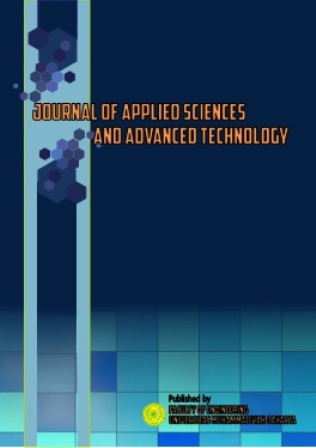Rail Leveling Analysis of Turning Radius and Speed Train Passenger Cart
DOI:
https://doi.org/10.24853/jasat.4.2.43-50Keywords:
Train Transportation Speed critical railwayAbstract
Needs consumer will tool transportation train fast fire on time now has sue Railway Corporation for Upgrade service and comfort for satisfaction para para consumer use tool transportation this in activity everyday. Look importance needs consumer will comfort use tool transportation train fire, then Writer interested for discuss comfort in journey train specifically problem journey train fire with elevation rail in pass Bend moment drove. Analysis done from Railway Corporation with literature assistance regarding problem railway. Remember breadth existing problems on train fire, then Writer limit only on calculation point heavy carriage, the forces that occur, and balance carriage when turn without and existence rail elevation. From result analysis carried out elevation data is taken rail maximum by 110 mm, radius curvature, speed plan maximum 120 km/h. Generate speed data critical in bend without elevation rail, and speed critical in bend existence rail elevation.Downloads
References
Honing, J., Railroad Building Science , Pradnya Paramitha Publisher, Jakarta, 1975.
Passenger Train, Maintenance Manual and Operation Instructions for Executive Class Passenger Trains , PT. INKA, 1996.
Morlok, Edwar, K, Introduction to Transportation Engineering and Planning, Erlangga, Jakarta, 1991.
Nelfiyanti, N., Ibnimatiin, R.A., Rani, A.M., Sudarwati, W. and Ramadhan, A.I., 2021. Design of Automotive Product Seat Lifting Aids in Minimizing MSD Complaints using AHOQ Method (Case Study: Final Line of Automotive Industry Assembly Process). Journal of Applied Sciences and Advanced Technology, 4(1), pp.25-34.
Subarkah, I, Jalan Kereta Api, Idhea Dharma Publisher, Bandung, 1981.
Mahmud, K.H., Yudistirani, S.A., Diniardi, E. and Ramadhan, A.I., 2020. Hardness Analysis of Bearing on Heat Treatment Process. Journal of Applied Sciences and Advanced Technology, 2(3), pp.59-64.
Bruni, S., Goodall, R., Mei, T.X. and Tsunashima, H., 2007. Control and monitoring for railway vehicle dynamics. Vehicle System Dynamics, 45(7-8), pp.743-779.
Almanda, D. and Ramadhan, A.I., 2020. Analysis of the Potential for Savings in Electrical Energy Consumption in Lifts: Case Study in Indonesia. Journal of Applied Sciences and Advanced Technology, 3(1), pp.29-34.
Yudistirani, S.A., Mahmud, K.H. and Diniardi, E., 2021. Stamping Disability Analysis on Material SPC 270 E. Journal of Applied Sciences and Advanced Technology, 3(3), pp.75-80.
Rahardja, I. B., Daraquthni, Z., & Ramadhan, A. I. (2019). Potential of Palm Oil Solid Waste as Steam Power Fuel (Case Study at XYZ Palm Oil Mill). Journal of Applied Sciences and Advanced Technology, 2(2), 33-38.
Mendia-Garcia, I., Gil-Negrete Laborda, N., Pradera-Mallabiabarrena, A. and Berg, M., 2022. A survey on the modelling of air springs–secondary suspension in railway vehicles. Vehicle System Dynamics, 60(3), pp.835-864.
Nakajima, T., Shimokawa, Y., Mizuno, M. and Sugiyama, H., 2014. Air suspension system model coupled with leveling and differential pressure valves for railroad vehicle dynamics simulation. Journal of Computational and Nonlinear Dynamics, 9(3).
Eickhoff, B.M., Evans, J.R. and Minnis, A.J., 1995. A review of modelling methods for railway vehicle suspension components. Vehicle System Dynamics, 24(6-7), pp.469-496.
Rahardja, I. B., Rikman, R., & Ramadhan, A. I. (2018). Analysis of Heat Transfer of Fiber Mesocarp of Palm Oil (Elaeis Guineensis Jacq) as Roof Building. Journal of Applied Sciences and Advanced Technology, 1(1), 1-8.
Rahardja, I. B., Dinary, R., & Ramadhan, A. I. (2019). Crystal Exergy Value (Wax) Crude Palm Oil (CPO) Influence Based On The Mixed Type. Journal of Applied Sciences and Advanced Technology, 1(3), 91-98
Eickhoff, B.M., Evans, J.R. and Minnis, A.J., 1995. A review of modelling methods for railway vehicle suspension components. Vehicle System Dynamics, 24(6-7), pp.469-496.
Kang, C.G., 2007. Analysis of the braking system of the Korean high-speed train using real-time simulations. Journal of Mechanical science and Technology, 21(7), pp.1048-1057.
Thomas, D., Berg, M. and Stichel, S., 2010. Measurements and simulations of rail vehicle dynamics with respect to overturning risk. Vehicle system dynamics, 48(1), pp.97-112
Bruni, S., Meijaard, J.P., Rill, G. and Schwab, A.L., 2020. State-of-the-art and challenges of railway and road vehicle dynamics with multibody dynamics approaches. Multibody System Dynamics, 49(1), pp.1-32.
Ribeiro, D., Calçada, R., Ferreira, J. and Martins, T., 2014. Non-contact measurement of the dynamic displacement of railway bridges using an advanced video-based system. Engineering Structures, 75, pp.164-180.
Szmagliński, J., Wilk, A., Koc, W., Karwowski, K., Chrostowski, P., Skibicki, J., Grulkowski, S., Judek, S., Licow, R., Makowska-Jarosik, K. and Michna, M., 2022. Verification of Satellite Railway Track Position Measurements Making Use of Standard Coordinate Determination Techniques. Remote Sensing, 14(8), p.1855.
Ma, F., Li, H., Hou, S., Kang, X. and Wu, G., 2022. Defect investigation and replacement implementation of bearings for long-span continuous box girder bridges under operating high-speed railway networks: A case study. Structure and Infrastructure Engineering, 18(5), pp.678-693.
Downloads
Published
Issue
Section
License
COPYRIGHT POLICY
The author(s) of an article published in the Journal of Applied Sciences and Advanced Technology (JASAT) retains ownership of the intellectual property rights in work (s).
PUBLISHING RIGHTS
The author(s) of an article published in the Journal of Applied Sciences and Advanced Technology (JASAT) have unrestricted publication rights. The authors give the Journal of Applied Sciences and Advanced Technology (JASAT) the right to publish the article and designate the Faculty of Engineering Universitas Muhammadiyah Jakarta Publishing as the original publisher of the article.
LICENSING POLICY
JASAT is an open-access journal that follows the Creative Commons Non-Commercial 4.0 International License (CC BY-NC 4.0), which states that:

Under this license, the reusers must give appropriate credit, provide a link to the license, and indicate if changes were made. Users may do so in any reasonable manner, but not in any way that suggests the licensor endorses users or their use.
Please take the time to read the whole license agreement (https://creativecommons.org/licenses/by-nc/4.0/). As long as reusers follow the license conditions, the owner cannot withdraw these freedoms. The following components are included under this license:
 Attribution: Users must provide appropriate attribution, including a link to the license, and indicate whether or not they made any modifications. Users are free to do so reasonably, but not in a manner that indicates the licensee approves of their usage.
Attribution: Users must provide appropriate attribution, including a link to the license, and indicate whether or not they made any modifications. Users are free to do so reasonably, but not in a manner that indicates the licensee approves of their usage.
 NonCommercial: Users may not use the material for commercial purposes.
NonCommercial: Users may not use the material for commercial purposes.












_2.png)


1.png)

2.png)
